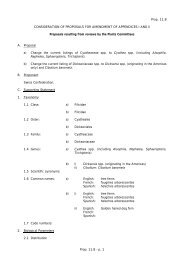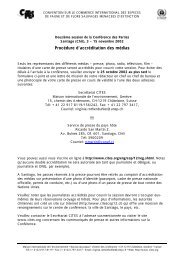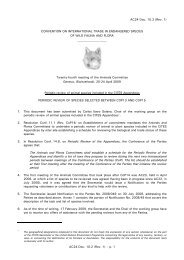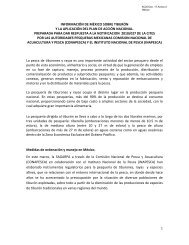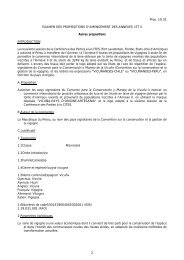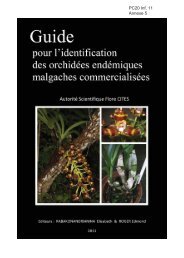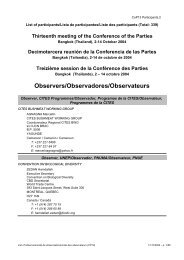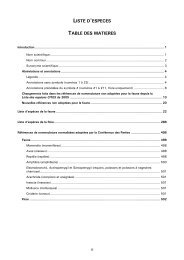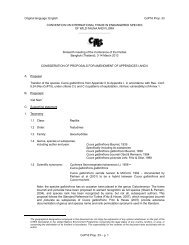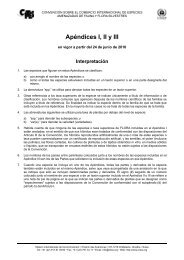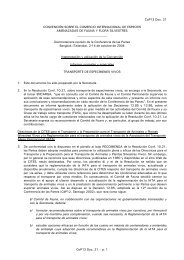Lamna nasus - Cites
Lamna nasus - Cites
Lamna nasus - Cites
You also want an ePaper? Increase the reach of your titles
YUMPU automatically turns print PDFs into web optimized ePapers that Google loves.
Draft Proposal to list <strong>Lamna</strong> <strong>nasus</strong> in Appendix II - prepared by Germany in January 2012<br />
3. Species characteristics<br />
3.1 Distribution<br />
In the Southern Hemisphere, in a circumglobal band of ~30–60 o S; in the North Atlantic Ocean and<br />
Mediterranean, between 30–70 o N (Compagno 2001, Figure 2). There are separate stocks in the Northeast and<br />
Northwest Atlantic (these were historically the largest global stocks), likely also in the Mediterranean, and in<br />
the Southeast and Southwest Atlantic. The latter two stocks extend into the Southwest Indian Ocean and<br />
Southeast Pacific, respectively. Other Indo-Pacific stocks have not been identified. Annex 3 lists Range States<br />
and FAO Fisheries Areas (Figure 3).<br />
3.2 Habitat<br />
Epipelagic in boreal and temperate seas of 2–18°C, but preferring 5–10 o C in the Northwest Atlantic (Campana<br />
and Joyce 2004, Svetlov 1978), from the surface to depths of 200m, occasionally to 350–700m. Most<br />
commonly reported on continental shelves and slopes from close inshore (especially in summer), to far<br />
offshore (where they are often associated with submerged banks and reefs). They also occur in the high seas<br />
outside 200 mile EEZs (Campana and Gibson 2008), where they are less abundant. Stocks segregate (at least<br />
in some regions) by age, reproductive stage and sex and undertake seasonal migrations within their stock area.<br />
(Campana et al. 1999, 2001, Campana and Joyce 2004, Compagno 2001, Jensen et al. 2002.) Mature females<br />
tagged off the Canadian coast appear to migrate 2000km south to give birth in deep water in the Sargasso Sea,<br />
Central North Atlantic; pups presumably follow the Gulf Stream to return north (Campana et al. 2010a).<br />
3.3 Biological characteristics<br />
<strong>Lamna</strong> <strong>nasus</strong> is active, warm-blooded, relatively slow growing and late maturing, long-lived, and bears only<br />
small numbers of young. It falls into FAO’s lowest productivity category of most vulnerable aquatic species.<br />
Life history characteristics vary between stocks and are summarised in Table 2. Northeast Atlantic sharks are<br />
slightly slower growing than the Northwestern stock. Both northern stocks are much larger, faster growing<br />
and have a shorter life span than the smaller, longer-lived (~65 years old) Southern Oceans porbeagles, which<br />
are therefore of even lower productivity and more vulnerable to overfishing than are North Atlantic stocks.<br />
3.4 Morphological characteristics<br />
Heavy cylindrical body, conical head and crescent-shaped tail (Figure 1). First dorsal fin has a distinctive<br />
white patch on the lower trailing edge.<br />
3.5 Role of the species in its ecosystem<br />
An apex predator, feeding on fishes, squid and some small sharks, but not on marine mammals (Compagno<br />
2001, Joyce et al. 2002). It has few predators other than humans, but Orcas and White Sharks may take it<br />
(Compagno 2001). DFO Canada (2006) could not demonstrate an ecosystem role at present low levels.<br />
Stevens et al. (2000) warn that the removal of top marine predators may have a disproportionate and counterintuitive<br />
impact on fish population dynamics, including by causing decreases in some prey species.<br />
4. Status and trends<br />
4.1 Habitat trends<br />
Critical habitats and threats to these habitats are largely unknown, although some North Atlantic mating<br />
grounds have been identified. High levels of ecosystem contaminants (PCBs, organo-chlorines and heavy<br />
metals) that bio-accumulate and are bio-magnified at high trophic levels are associated with infertility in<br />
sharks (Stevens et al. 2005), but their impacts on L. <strong>nasus</strong> is unknown. Effects of climatic changes on world<br />
ocean temperatures, pH and related biomass production could potentially impact populations.<br />
4.2 Population size<br />
Effective population size (as defined in Resolution Conf. 9.24 (Rev. CoP14) Annex 5), is best defined by the<br />
number of mature females in the population, particularly in heavily fished stocks dominated by immatures or<br />
males 2 . The only stock for which population size data are available is in the Northwest Atlantic. Recent stock<br />
2<br />
The FAO guidance for evaluating commercially aquatic species for listing in CITES (FAO 2001) stresses the<br />
importance of this consideration.<br />
Page 3 of 14<br />
AC26 Doc. 26.2, Annex 1 – p. 3<br />
AC26 Doc. 26.2<br />
Annex / Anexo /Annexe<br />
(English only / únicamente en inglés / seulement en anglais)




